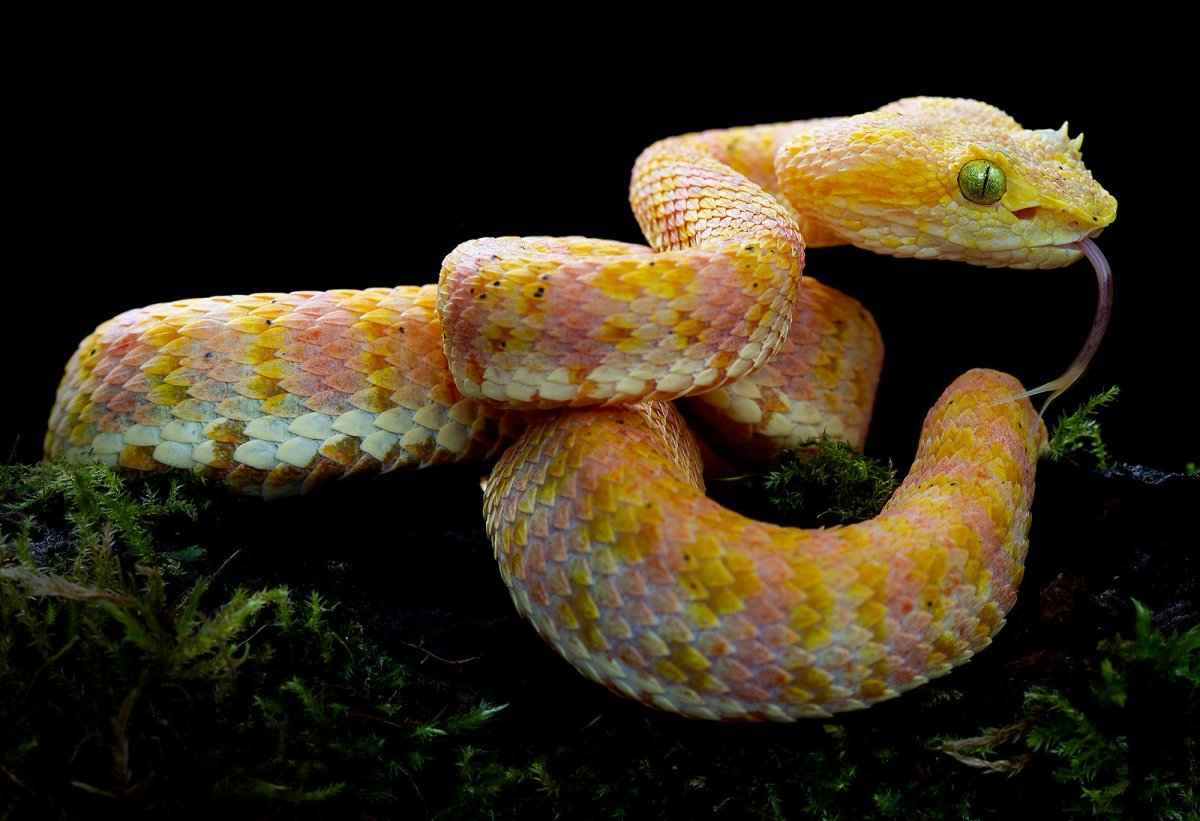Five new species of brightly colored vipers have been discovered, hidden deep within the cloud forests of Colombia and Ecuador.
The eyelash vipers were all previously thought to be part of a single species, but research into the snakes kicked off after a scientist was bitten by one in 2013, according to a new paper in the journal Evolutionary Systematics.
Four of the five new species are already considered to be facing extinction, the researchers explain, mostly due to their limited habitat being destroyed. Between 50 and 80 percent of their small geographical range has already been wrecked, and they face even more destruction.

The five new species are named the Rahim's Eyelash-Pitviper (Bothriechis rahimi), the Hussain's Eyelash-Pitviper (B. hussaini), the Shah's Eyelash-Pitviper (B. rasikusumorum), the Klebba's Eyelash-Pitviper (B. klebbai) and the Khwarg's Eyelash-Pitviper (B. khwargi), in honor of several major supporters of conservation and the protection of biodiversity. Three of the five are endemic to cloud forests and coffee plantations in the eastern Cordillera of Colombia, while the Hussain's Eyelash-Pitviper is found in southwestern Ecuador and northwestern Peru, and the Rahim's Eyelash-Pitviper is found in the Chocó rainforest at the border between Colombia and Ecuador.
These new species are all eyelash vipers, named for their characteristic ridge of scales above their eyes. The function of these features, while intimidating, remains a mystery to researchers, but some populations have longer "eyelashes" than others.
These snakes are venomous, but are not thought to be as deadly as other species of eyelash viper. Paper co-author Lucas Bustamante, a biologist and wildlife conservation photojournalist from Ecuador, was the researcher bitten by a Rahim's Eyelash-Pitviper during an expedition.
"Among the 10 species of eyelash vipers, the one having the most lethal and hemorrhagic is the Central American Eyelash-Viper (Bothriechis nigroadspersus)," co-author Alejandro Arteaga, a reptile researcher and president of Ecuadorian biodiversity NGO the Khamai Foundation, told Newsweek.
"In humans, it causes intense localized pain, progressive hemorrhagic edema, and, in some cases, hemorrhagic blisters or hives, ecchymoses, and necrosis. The venom of the Colombian and Ecuadorian eyelash vipers is considerably less lethal. In the latter, most envenomations are moderate, mild, or without systemic complications. However, one coffee plantation worker died after being bitten on the tongue by the Highland Eyelash-Viper (Bothriechis schlegelii)."
Eyelash vipers have another unique feature in that they are polychromatic, meaning that members of the same species may have very different colors to each other, which are known as morphs. The same habitat may be home to several different color morphs from the same species, such as a turquoise morph, a moss morph, gold morph, purple morph and even a "Christmas" morph. This variation in color may have evolved to allow the vipers to hide among a greater variety of plants and backgrounds, though the exact reason for the morph system is unknown.

The researchers noted that these discoveries highlight the importance of protecting the forests that these snakes and millions of other species call home.
"The need to protect eyelash vipers is critical, since unlike other snakes, they cannot survive without adequate canopy cover. Their beauty, though worthy of celebration, should also be protected and monitored carefully, as poachers are notorious for targeting charismatic arboreal vipers for the illegal pet trade of exotic wildlife," Arteaga said in a statement.
They may have also discovered a sixth new species, but that wasn't confirmed in the new paper, as more research needs to be done.
"We have at least another new species confirmed, but as many as three or four additional species of eyelashes may remain undescribed in Colombia, Ecuador, and Panama," Arteaga said.
Do you have a tip on a science story that Newsweek should be covering? Do you have a question about the vipers? Let us know via science@newsweek.com.
Update 2/20/2024, 12:38 p.m. ET: This article was updated with comment from Alejandro Arteaga.
Uncommon Knowledge
Newsweek is committed to challenging conventional wisdom and finding connections in the search for common ground.
Newsweek is committed to challenging conventional wisdom and finding connections in the search for common ground.
About the writer
Jess Thomson is a Newsweek Science Reporter based in London UK. Her focus is reporting on science, technology and healthcare. ... Read more
To read how Newsweek uses AI as a newsroom tool, Click here.





